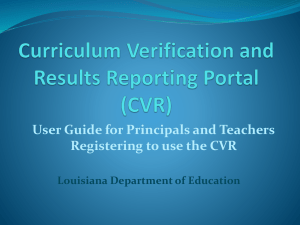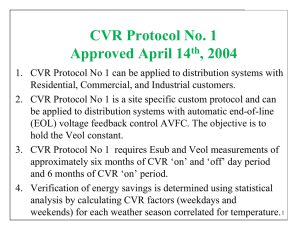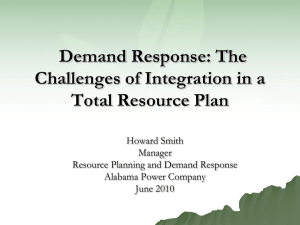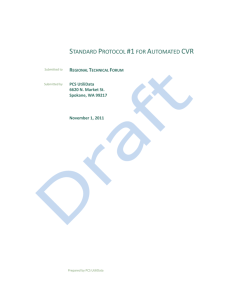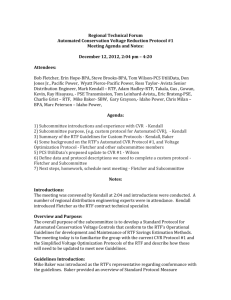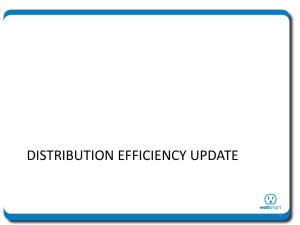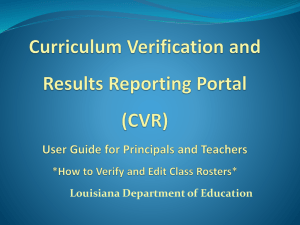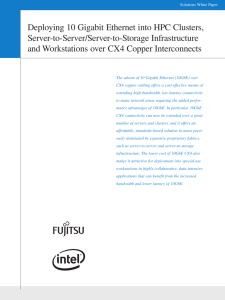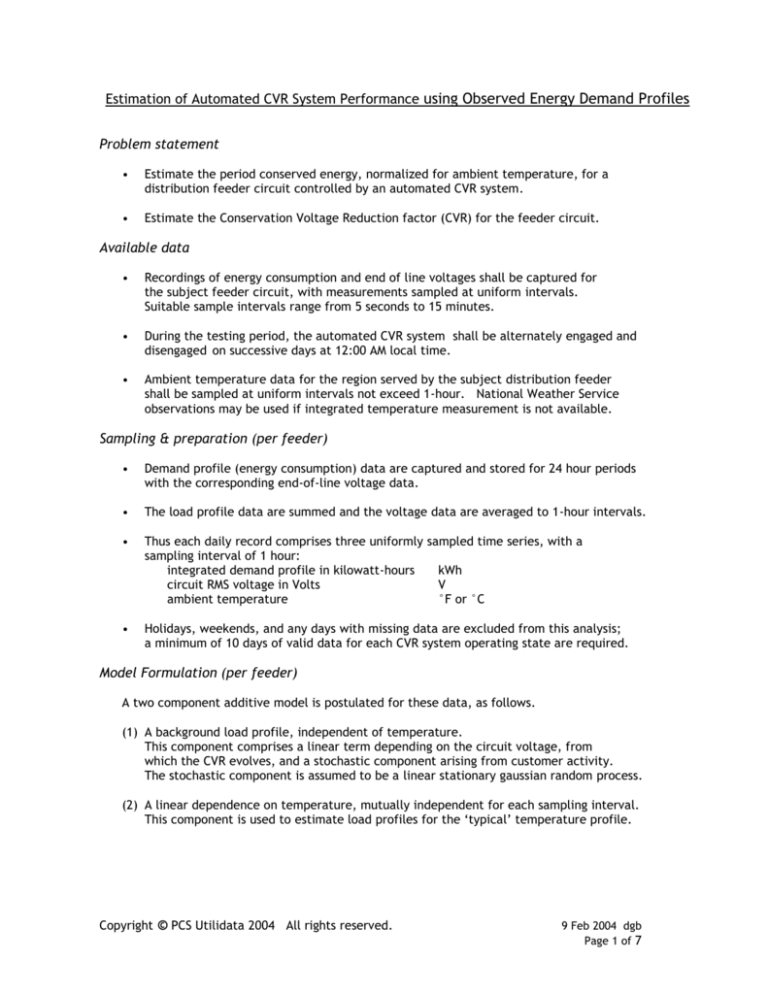
Estimation of Automated CVR System Performance using Observed Energy Demand Profiles
Problem statement
•
Estimate the period conserved energy, normalized for ambient temperature, for a
distribution feeder circuit controlled by an automated CVR system.
•
Estimate the Conservation Voltage Reduction factor (CVR) for the feeder circuit.
Available data
•
Recordings of energy consumption and end of line voltages shall be captured for
the subject feeder circuit, with measurements sampled at uniform intervals.
Suitable sample intervals range from 5 seconds to 15 minutes.
•
During the testing period, the automated CVR system shall be alternately engaged and
disengaged on successive days at 12:00 AM local time.
•
Ambient temperature data for the region served by the subject distribution feeder
shall be sampled at uniform intervals not exceed 1-hour. National Weather Service
observations may be used if integrated temperature measurement is not available.
Sampling & preparation (per feeder)
•
Demand profile (energy consumption) data are captured and stored for 24 hour periods
with the corresponding end-of-line voltage data.
•
The load profile data are summed and the voltage data are averaged to 1-hour intervals.
•
Thus each daily record comprises three uniformly sampled time series, with a
sampling interval of 1 hour:
integrated demand profile in kilowatt-hours
kWh
circuit RMS voltage in Volts
V
ambient temperature
°F or °C
•
Holidays, weekends, and any days with missing data are excluded from this analysis;
a minimum of 10 days of valid data for each CVR system operating state are required.
Model Formulation (per feeder)
A two component additive model is postulated for these data, as follows.
(1) A background load profile, independent of temperature.
This component comprises a linear term depending on the circuit voltage, from
which the CVR evolves, and a stochastic component arising from customer activity.
The stochastic component is assumed to be a linear stationary gaussian random process.
(2) A linear dependence on temperature, mutually independent for each sampling interval.
This component is used to estimate load profiles for the ‘typical’ temperature profile.
Copyright © PCS Utilidata 2004 All rights reserved.
9 Feb 2004 dgb
Page 1 of 7
Estimation of Automated CVR System Performance - continuation
Analysis Procedure (per distribution feeder)
(1)
The demand profile time series are arranged into two ensembles, one for the CVR system
engaged loads and one for the CVR system disengaged loads.
(2)
The end of line voltage time series are arranged into two ensembles, one for the CVR system
engaged loads and one for the CVR system disengaged loads.
(3)
The ambient temperature time series are arranged into two ensembles, one for the CVR
system engaged loads and one for the CVR system disengaged loads.
(4)
The vectors of ensemble average end-of-line voltages are estimated using either
an L1 median procedure or MCD robust regression.
(5)
The vectors of energy demand and ambient temperature are sorted by the temperature
observation, into two groups above and below the standard ASHRAE ‘comfort’ temperature,
nominally 65°F.
(6)
Linear models are estimated for each group of temperature-sorted observations in step (5),
and the ratio of their slopes is computed as the slope above 65 °F divided by the slope
below 65 °F.
(7)
The explanatory variable representing temperature for estimation purposes is the deviation
of the ambient temperatures from the ASHRAE comfort temperature in which the deviations
above the comfort temperature are multiplied by the slope ratio computed in step (6).
(8)
The vectors of linear terms for temperature dependence of the loads are estimated by MCD
robust regression of energy against the temperature variable in step (7).
(9)
The temperature profile for the ‘average’ day is estimated from the ensemble of hourly
temperature data using either an L1 median procedure or MCD robust regression.
(10)
The expected demand profiles, one each for the CVR system engaged and disengaged, are
computed by applying the ‘average’ day temperature profile to the temperature model for
each CVR system state.
(11)
The difference between the expected load profiles represents the conservation profile,
which is compared to the difference between the end-of-line voltage profiles to
estimate a vector of CVR factors.
(12)
The per-feeder scalar CVR factor is the mean of the CVR vector, weighted by the CVR system
disengaged demand profile.
Notes
•
The present analysis applies equally to all ambient temperatures.
Copyright © PCS Utilidata 2004 All rights reserved.
9 Feb 2004 dgb
Page 2 of 7
Estimation of Automated CVR System Performance - continuation
Comments on the proposed procedure
Available data
We acknowledge that the observations of the ambient temperature may lack suitable resolution
with respect to location in some cases, since it is believed that the subject terrain contributes to
the significant local variation in ambient temperature and wind velocity. We also acknowledge
that the estimate of the expected daily temperature profile could also be improved upon.
We expect that the variance in the estimates of temperature dependence parameters will
thus be larger than the best achievable variance associated with estimates using spatially
detailed temperature observations. However, this defect in the observations does not
undermine the physical suitability of the proposed linear dependence of energy consumption
on temperature.
We note here that the magnitude of the temperature dependence will depend on whether
the principal utility loading for environment control is heating or cooling; it is expected that
cooling will require more energy per unit temperature compensation, entirely as a result of
the inferior energy conversion efficiency of cooling equipment.
Model formulation
The principal objective of the present analysis is to estimate the magnitude of conserved
energy resulting from a small reduction in the delivered voltages. Ideally, this estimate
would be made by adjusting the delivered voltage and observing the response of the
connected load, under conditions in which every important characteristic of the load was
identical before and after the voltage adjustment. This test condition is in no way achievable
in practice.
The alternative, of course, is to attempt such an estimate by identifying a physically
suitable model of the load process, such that the behavior of the load process can be evaluated
under identical simulated conditions. In the present case, models for the standard load process
and the reduced voltage load process are estimated, and their outputs compared for a
simulated representative temperature input.
We acknowledge without reservation that we lack sufficient data to identify some expected
dependencies in the load process model. For example, the available observations clearly show
that the ‘weekday’ load process differs from the ‘weekend’ load process; however, clear
identification of the difference between the ‘Tuesday’ and ‘Friday’ load processes, known to
exist in practice in some utility load distributions, cannot be identified with confidence from
the small number of available observations.
The load process, characterized by the so-called load profile, is inherently cyclostationary
with a natural period of one day. Since the objective here is not the explicit identification of
the load profile, we are not interested in cyclic autocorrelation or any other temporal statistics
of any order that exploit the periodicity of the load data. I repeat, we make no attempt to
formulate or identify a time domain model for the load profile and thus have no use whatever
for temporal measures for parameter estimation.
However, we do exploit the cyclic behavior of the load for the alignment of the members
of the process ensemble, including only those cycles (weekdays) that are expected to originate
from the same load process dynamics, which in turn behave according to the previously stated
properties. Samples taken at different times are assumed to be independent (in the sense of
De Moirve), so that the resulting estimates of temperature dependence are easily computed
using only observations for each time interval.
Copyright © PCS Utilidata 2004 All rights reserved.
9 Feb 2004 dgb
Page 3 of 7
Estimation of Automated CVR System Performance - continuation
Comments on the proposed procedure - continuation
Forecasting
The proposed model may be applied to the problem of forecasting conservation if specific
constraints are met and known limitations are observed.
•
The present formulation excludes daylight duration and other expected seasonal variables.
Thus any forecast for a given season must use estimation results from that season in prior years.
•
The ambient temperature formulation is not well suited for extrapolation, so that the daily
temperature profile in the forecast interval is bounded by temperature profile observations
in the estimation reference interval.
•
The present formulation easily accommodates load growth on a given feeder circuit under the
broad assumption that such growth is demographically similar, such that the stochastic behavior
of the load is second order stationary.
Exemplary References
The literature on the subject of time series analysis is extensive; we cite here a few
references which are generally well regarded by experts in the field.
Fundamentals
Parzen, E.: Stochastic Processes
SIAM 1999, ISBN 0898714419
Gold, B., Rader, C.M., Oppenheim, A.V., Stockham, T.G.: Digital Processing of Signals
McGraw-Hill 1969
Wiener, N.: Extrapolation, Interpolation, and Smoothing of Stationary Time Series
Wiley 1949
Statistics and Estimation
Box, G.E.P, Jenkins, G.M.: Time Series Analysis, Forecasting and Control
Holden-Day 1976, ISBN 0816211043
Bendat, J.S., Piersol, A.G.: Random Data Analysis and Measurement Procedures
Wiley 1971, ISBN 047106470X
Rousseeuw, P.J., Leroy, A.M.: Robust Regression and Outlier Detection
Wiley 1987, ISBN 0471852333
Engineering
Himmelblau, D.M., Bischoff, K.B.: Process Analysis by Statistical Methods
Wiley 1969
Helstrom, C.W.: Statistical Theory of Signal Detection
Pergamon Press 1975, ISBN 0080132650
Copyright © PCS Utilidata 2004 All rights reserved.
9 Feb 2004 dgb
Page 4 of 7
Estimation of Automated CVR System Performance - continuation
Formulation Details for Comfort Heating Conditions – per distribution feeder basis
Observables
s0
s 1
ps
x si
tj
T (t j , xsi )
vs (t j , xsi )
Es (t j , x si , T ji , vsji )
Automated CVR system state indicator: system disengaged
Automated CVR system state indicator: system engaged
number of samples (time series records) in ensemble
s
1 i ps
1 j n
daily cycle index, the ensemble axes
sample time index, the time axis
ambient temperature surface
end of line voltage surfaces
energy consumption (load profile) response surfaces
Model Components
P(x)
TR
TR T
s (t j )
ws (t j )
stochastic component of load profiles
heating/cooling comfort reference temperature ( == 65°F)
heating comfort temperature
linear slopes, energy vs temperature
estimated load profiles at reference temperature
Statistics
vs (t j )
Tm (t j )
Ws (t j )
ensemble ‘median’ voltage profiles
ensemble (combined off & on) median comfort temperature profile
estimated load profiles at ensemble median temperature
Results
conservation factor
Copyright © PCS Utilidata 2004 All rights reserved.
9 Feb 2004 dgb
Page 5 of 7
Estimation of Automated CVR System Performance - continuation
Formulation Details... - continuation
Salient Assumptions
n 24
number of hourly samples per one daily period
P(x)
stochastic component of load profile
zero mean, wide-sense stationary, unknown probability density
deterministic component of load profile is linear in
end of line voltage over the voltage interval of interest
probability structure of the energy/temperature slopes is unknown,
thus robust regression procedures are indicated
P( xa | xb ) P( xa )
The ‘random’ component of observations at any given times
a, b
are mutually independent.
Formulation
Es (t , x, T , v ) ws (t )[1 P( x )] [TR T (t , xs )] s (t )
where
s0
s 1
Automated CVR system disengaged
Automated CVR system engaged
Analysis
Manually segregate daily profiles on the basis of ambient temperature, since we expect that
the temperature dependence of the load profile will differ when heating or cooling for comfort.
Form ensembles of daily profiles on the basis of Automated CVR system state.
Perform MCD robust regression on the ensemble axis for energy consumption against comfort
temperature for each ensemble, estimating:
ws (t j )
and
s (t j )
for
s 0,1
and
1 j n
.
(Formulas for Minimum Covariance Determinant (MCD) robust regression can be found in:
Rousseeuw, P.J., and Leroy, A.M.: “Robust Regression and Outlier Detection”, Wiley, 1987.
Copyright © PCS Utilidata 2004 All rights reserved.
9 Feb 2004 dgb
Page 6 of 7
Estimation of Automated CVR System Performance - continuation
Formulation Details... - continuation
Analysis - continuation
vs (t j , xi ) ,
1 j n :
Compute the L1 location estimate of the end-of-line voltage observations
estimating the expected voltage profiles
vs (t j )
for
s 0,1
and
ps
vs (t j ) min vs (t j ) vs (t j , xsi )
i 1
T (t j , xi ) ,
1 j n .
Compute the L1 location estimate of the ambient temperature observations
estimating the expected comfort temperature profile
Tm (t j )
p
Tm (t j ) min Tm (t j ) T (t j , xi )
, where
i 1
for
p p0 p1
Compute the expected load profiles (energy consumption time series for a one day period), so that
each load process (automated CVR system engaged or disengaged) is evaluated with the same
comfort temperature input:
Ws (t j ) ws (t j ) [TR Tm (t j )] s (t j )
Compute the CVR factor, thus normalized for comfort temperature:
[W0 (t j ) W1(t j )]
100
j
1
[W0 (t j )][ v0 (t j ) v1 (t j )]
n j
j
j
,
which has physical units of percent energy consumption difference per volt difference.
This quantity may of course be expressed in other relevant scales without altering the above
algorithm, such as percent energy consumption difference per percent voltage difference.
This procedure should be repeated for observations under cooling for comfort conditions,
since the energy/temperature slopes are expected to be greater by a factor of 2.0 to 3.0 .
________________________________________
j:\tom\rtf\2004_0210\avc performance estimation expert robust.doc
Copyright © PCS Utilidata 2004 All rights reserved.
9 Feb 2004 dgb
Page 7 of 7

